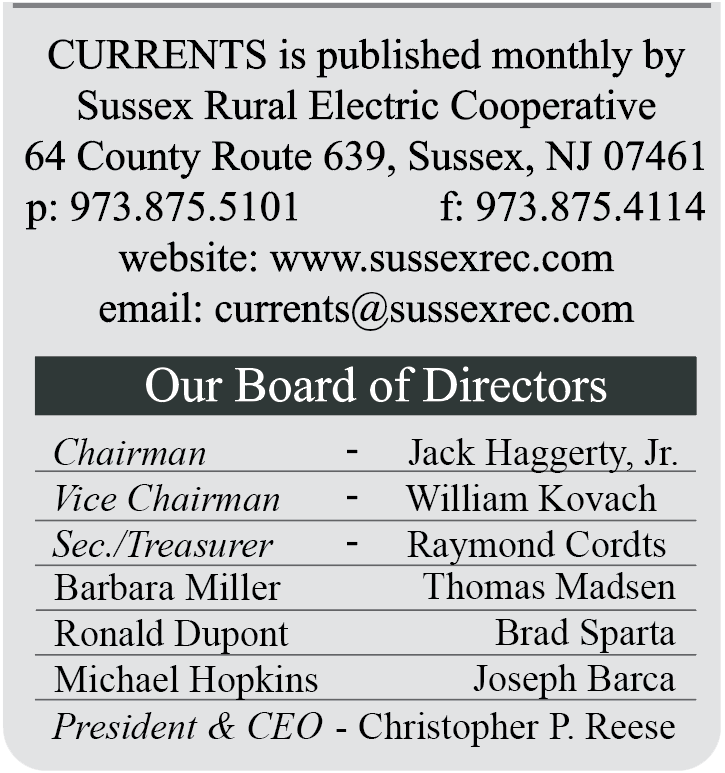To view the full print/pdf version of this issue of Currents, click here
For previous issues of Currents, visit our Currents Library
Introduction

By: Chris Reese, President & CEO
Email: contacttheceo@sussexrec.com
Sussex Rural Electric Cooperative has steadfastly held to its mission of supplying our community with affordable, reliable electricity since we were founded in 1937. Of course, acquiring this power is a big undertaking and something a distribution cooperative like ours does not do alone.
We distribute power that comes from our energy supplier, Allegheny Electric Cooperative, Inc., of which Sussex Rural Electric Cooperative is a part-owner. Allegheny is celebrating its 75th anniversary this year and we felt this would be a great opportunity to give our members some insight into where we get the electricity that powers your homes (it’s not from a neighboring, investor-owned utility). Kathy Hackleman from our statewide association wrote a fantastic article for their magazine, Penn Lines, that gives great insight into Allegheny’s history and role in powering rural communities like ours. I hope you enjoy!
Built to Last
By: Kathy Hackleman, Senior Editor/Writer, Penn Lines Magazine
Electricity is a simple concept to understand — you flip a switch or insert a plug into an outlet and voila, good things happen. Your light comes on. Your coffee is hot. Your phone is charged. Your garage door goes up so you can leave for work. But how that all happens is a more difficult concept to wrap your head around.
In its simplest terms, the “how” of electricity can be compared to the country’s highway system that brings a newly bought coffeepot to your doorstep. Chances are, your coffeepot is waiting for you at a warehouse near a major, multi-lane highway. By phone or online, you let the company know you want to trade some of your money for one of its coffeepots. The coffeepot leaves the warehouse, exiting the highway at a narrower, less busy highway, followed eventually by traveling down your county road before arriving at your house.
That’s the same path that electricity takes — it moves from the warehouse (the generation plant), down a series of ever-smaller highways (transmission lines and substations), until it finally arrives at your home via a small county road (the distribution cooperative’s service lines that provide power to your local residences and businesses).
This year, Sussex Rural Electric Cooperative’s generation/transmission provider — Harrisburg, Pa.-based Allegheny Electric Cooperative, Inc. (Allegheny) — is celebrating its 75th anniversary, many times referred to as a “diamond anniversary.” Every electric cooperative member is familiar with their local electric cooperative, and many could describe where the nearest cooperative substation is located. Few could trace their power all the way back to its generation source.
Cooperation
“Incredible changes have taken place in the industry since Allegheny’s first board meeting in 1946,” says Frank Betley, president & CEO of Allegheny and the Pennsylvania Rural Electric Association (PREA), the statewide organization representing the Pennsylvania and New Jersey electric cooperatives. “Allegheny was formed as a way to purchase power at a more reasonable cost than when each cooperative purchased it individually. In the years since then, Allegheny has transitioned from buying all of the power needed by the cooperatives to owning the majority of our generation.”
The one thing that has not changed, however, is the organization’s goal of supplying safe, reliable, and affordable electricity to cooperative members, Betley emphasizes.
“We meet nearly 70% of our generation needs from our own clean, carbon-free resources, including a 10% ownership share in a nuclear power plant — the Susquehanna Steam Electric Station — and a hydro plant — the Raystown Hydroelectric Project, along with long-term contracts with the New York Power Authority for hydropower generated there,” Betley notes. “That means we are not at the mercy of the price changes often reflected in the open market, and it is one of the major reasons we have continued to be among the most competitively priced electricity providers through the years.”
Early Mission
The first formal step toward the creation of what would become Allegheny Electric Cooperative, Inc. was taken on March 17, 1944, at a PREA meeting. PREA was established by the cooperatives in 1942 and its board is also made up of one director from each electric cooperative in Pennsylvania and New Jersey.
Early on, private power companies showed little interest in serving rural customers, due mostly to the long distances they would have to string lines for only a few customers, making it financially less lucrative than more populated areas. Once the formation of Allegheny was announced, however, the private power companies attempted to stop the incorporation of the new cooperative. The subsequent lawsuit went to the state Supreme Court, which ruled in favor of the cooperatives. Soon thereafter, the state granted a charter to Allegheny.
The first official meeting of the new generation and transmission cooperative was held in July 1946 with the first order of business being to begin negotiating with private power companies to purchase power for the electric cooperatives at a discounted price. Within a year, the private power companies had agreed to a deal that would save Pennsylvania and New Jersey cooperatives (and ultimately, their members) about 20% of what they had been paying.
One of the early actions by the Allegheny board continues to be financially beneficial today. In 1966, Allegheny entered into a long-term, low-cost power supply agreement with the Power Authority of the State of New York (now known as the New York Power Authority or NYPA). Since then, this agreement has saved Pennsylvania and New Jersey’s member cooperatives an estimated $414 million compared to the cost of buying power from other sources.

In a bid to control their own future, Allegheny researched a number of possible power supply sources and eventually purchased a 10% ownership of the Susquehanna Steam Election Station (SSES), a nuclear power plant near Berwick, Pa. Unit 1 of SSES began commercial operation in June 1983 while Unit 2 came on-line in February 1985. Today, the nuclear power plant provides approximately 60% of the annual power needs of Pennsylvania and New Jersey cooperatives. Now operated by Talen Energy Corporation, the facility set a generation record in 2019, sending 20,919 gigawatt-hours of electricity to the grid with no unplanned outages for either unit.
Allegheny also built a small hydroelectric project at Raystown Lake near Huntingdon, Pa. The hydroelectric project at Raystown Lake began commercial operations in 1988. In recent years, it has provided 2.5-3.5% of the cooperatives’ power needs each year.
Energy Initiatives
During the same time frame as SSES and the Raystown Hydroelectric Project were in the planning and construction stages, Allegheny was exploring other ways to provide affordable, reliable power to member cooperatives.
“Over the years, we’ve seen an increase in renewable sources of power … and have come to realize that the most cost-effective kilowatt-hour is the one that is never generated,” Betley explains. “As a result, we’ve focused on the development of energy efficiency initiatives.”
In 1983, a pilot project at three Pennsylvania electric cooperatives revealed direct control of home electric water heaters could be used as a way to smooth out peak periods of electric use to reduce monthly demand charges for cooperatives. Electricity is the most expensive during peak use periods, so curbing demand during those periods reduces costs for cooperatives (and thus the members).
This led to the launch of Allegheny’s effort to manage electric loads during peak periods, known as the coordinated load management system, in 1986. Since then, this initiative, known by some members as “the water heater program,” has resulted in a total savings to cooperatives of nearly $155 million in avoided purchased power costs, and has been recognized as a model of energy efficiency and demand response innovation.
“The coordinated load management system works because cooperatives, which are member-owned, are focused on keeping power costs affordable for members, not maximizing profits,” explains Todd Sallade, PREA/Allegheny vice president — power supply & engineering.
In more recent action, in 2006, Pennsylvania and New Jersey cooperatives began partnering with Allegheny to coordinate the interconnection of consumer-owned, renewable energy projects to cooperative lines. According to Sallade, as of the end of December 2020, more than 700 projects, including solar arrays, wind turbines, anaerobic digesters, and one hydro facility, have been interconnected with cooperative lines. The nameplate capacity of the projects is close to 10 megawatts.
To help offset a cooperative’s costs in the interconnection process, funds from PREA’s Renewable Energy Assistance Program (REAP) have been used for most of the projects. The program provides grants to electric cooperatives to cover various interconnection and transitional costs to help ensure that other cooperative consumer-members are not required to subsidize the installation of an individual cooperative member-owned renewable energy system. REAP grants are funded through the sale of renewable energy certificates produced by the Raystown Hydroelectric Project.
In an even more innovative energy-efficiency program in 2018, the cooperatives and Allegheny worked together to distribute nearly a million 60-watt-equivalent LED lightbulbs free to all cooperative members within the two states (four to each household and business). The philosophy behind the distribution was that if cooperative members immediately switched out four incandescent lightbulbs and installed their four new LED lightbulbs, they would save energy. Lots of it. Allegheny staff estimated that if all members switched out the bulbs, each member would save more than $500 over the life of the four bulbs. And just as importantly, widespread participation in the program continues to drive down costs for all members as power supply needs during peak demand periods fall with the substitution of the energy-efficient LED bulbs for older, energy-gobbling incandescent bulbs.

Coordination
“All of these things working together is what makes the system run,” Sallade notes. “From NYPA, the nuclear plant and Raystown, to the load management program and other, more-recent energy efficiency initiatives, the goal has been keeping costs down for cooperative members. And we’ve been largely successful. For many years, Allegheny’s generation rates for consumer-members have been among the lowest and most stable in the region.”
“The energy industry can be volatile, and many companies have come and gone during the past 75 years,” Betley observes. “But because of their member-driven focus and ability to adapt to changing conditions, cooperatives have demonstrated they have staying power. Cooperatives are built to last, and Allegheny looks forward to the next 75 years of serving its members.”
You can read the full article from Penn Lines, the official PREA magazine, at sussexrec.com/built-to-last-full.
We've also produced an explainer video on how your power gets from the power plant to your home. You can find it here.




